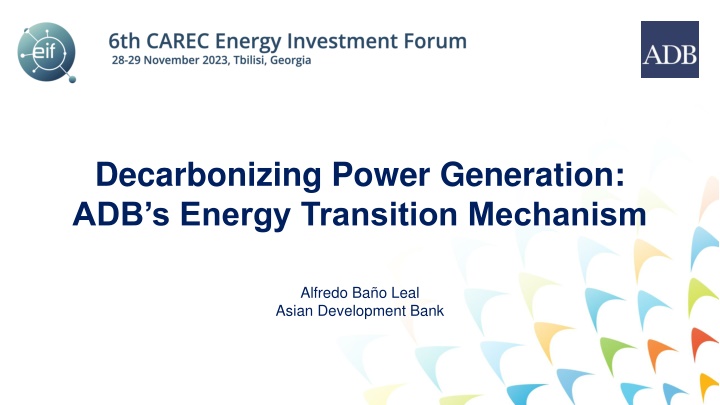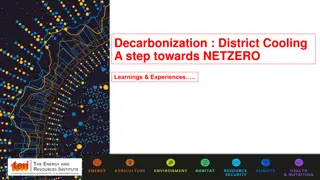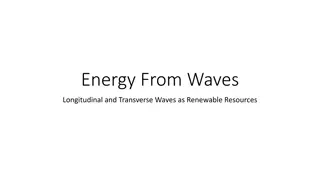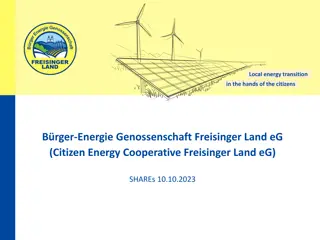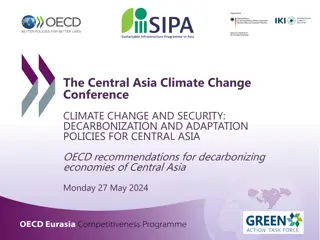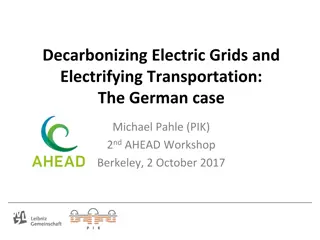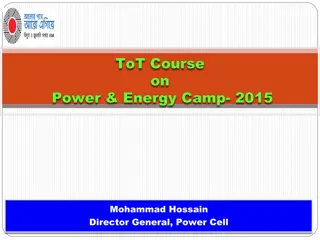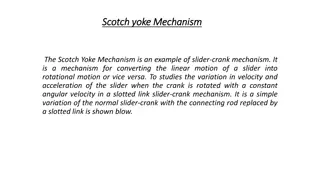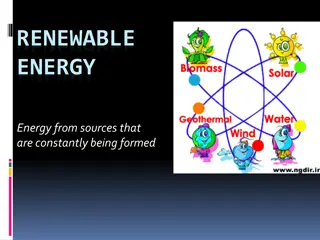Energy Transition Mechanism Overview for Decarbonizing Power Generation
Energy Transition Mechanism (ETM) is a program led by the Asian Development Bank to support the transition to clean energy by providing funding, grants, and technical assistance. It involves partnerships with investors, lenders, governments, and philanthropies to facilitate coal retirement transactions, clean energy projects, and carbon reduction initiatives. The ETM aims to drive the decarbonization of power generation in Asia through various financial mechanisms and support activities.
Download Presentation

Please find below an Image/Link to download the presentation.
The content on the website is provided AS IS for your information and personal use only. It may not be sold, licensed, or shared on other websites without obtaining consent from the author.If you encounter any issues during the download, it is possible that the publisher has removed the file from their server.
You are allowed to download the files provided on this website for personal or commercial use, subject to the condition that they are used lawfully. All files are the property of their respective owners.
The content on the website is provided AS IS for your information and personal use only. It may not be sold, licensed, or shared on other websites without obtaining consent from the author.
E N D
Presentation Transcript
Energy Transition Mechanism Decarbonizing Power Generation: ADB s Energy Transition Mechanism May 2022 Alfredo Ba o Leal Asian Development Bank PUBLIC. This information is being disclosed to the public in accordance with ADB s Access to Information Policy.
A Coal-Powered Asia Electricity Production per source, 2000-2022 (in TWh) OECD Asia World India PRC ASEAN ASEAN = Association of South-East Asian Nations, OECD = Organisation of Economic Cooperation and Development, PRC = People s Republic of China, TWh = terawatt hour PUBLIC. This information is being disclosed to the public in accordance with ADB s Access to Information Policy.
is contributing to Climate Change Carbon Intensity of Energy Production, 2000-2021 (kgCO2 / kWh) Annual CO2 Emissions by World Region (tCO2 billion) CO2 = carbon dioxide, EU = European Union, kg = kilograms, kWh = kilowatt hour, t = metric ton, USA = United States of America PUBLIC. This information is being disclosed to the public in accordance with ADB s Access to Information Policy.
Energy Transition Mechanism Overview International and local investors and lenders IFIs and global climate finance Governments and Philanthropies Grants and highly concessional funding* Grant, debt, equity, or guarantee Coal retirement transactions (asset level) Concessional finance** ETM Funding Vehicle ETM Partnership Trust Fund (ADB-administered)1 Carbon Reduction Facility (CRF) Clean Energy Facility (CEF) Clean energy transactions (asset level) * Grants and highly concessional funding (low-cost equity and debt) are critical to catalyze private capital and make ETM a success. Direct ADB Transactions (Sovereign or nonsovereign sectors with potential IFIs cofinancing) Corporate transactions (portfolio level) Grid, technical, and financial analyses Just Transition (e.g., skills and livelihood development) and social/environmental safeguards Policy and regulatory support Carbon finance (e.g., carbon credit structuring) Measurement, reporting, and verification ** Concessional finance may include concessional loans, evergreen debts, junior equities, and guarantees. Technical assistance (e.g.): Just Transition activities to be supported in line with agreed JT plan. 1 ETMPTF has received contributions from the Governments of Japan ($25 million) and Germany ( 30 million). https://www.adb.org/what-we-do/energy-transition-mechanism-etm Details are publicly available at: PUBLIC. This information is being disclosed to the public in accordance with ADB s Access to Information Policy.
ETM Feasibility Study Process 03 04 02 01 Environmental, Social, and Governance Transaction Structuring and Financial Analysis Fund/Vehicle Structuring Project Selection Replacement plan for retired capacity to ensure ETM has positive climate impacts Socioeconomic impact assessment of direct, indirect, and induced impacts in the coal value chain due to CFPP early retirement Planning of Just Transition activities and funding needs over short- and long-term Strategic environmental and social assessment of ETM options Asset-level audits Critical factors to focus on when selecting power plants: o Grid stability o Utilization o Plant age o Renewable replacement potential o Transactional appetite Commercial and legal structure to efficiently retire the assets Valuation approach Role of existing stakeholders Cost of capital needed to achieve a significant lifetime reduction Potential additional revenue sources or costs (e.g., carbon and decommissioning) Legal structure of ETM entity Capital structure and sources of funding Management structure Incentive structure Return expectations Major risks Safeguard policy Governance requirements PUBLIC. This information is being disclosed to the public in accordance with ADB s Access to Information Policy.
Transaction Structuring Models Synthetic Model (SPV Level) 02 03 Portfolio Model (Corporate Level) Acquisition Model1 (SPV Level) 01 ETM provides funding to the corporate sponsor with CFPPs and greenfield clean energy projects Sponsor guarantees energy projects will be built and coal plants retired ahead of schedule ETM invests senior/junior debt and/or other mezzanine capital to the CFPP ETM acquires share capital in CFPP Equity responsibility kept with the current asset owner Investment conditional on early termination being contractually agreed with owner and utility and appropriate security being provided ownership and operational greenfield clean ETM to take role as owner and operator of the coal plant ETM agrees an early termination date with the utility and operates the plant until that date and then closes it or repurposes Incentives (such as penalty interest) can be used to ensure that the transition occurs Most suitable for IPP international bankable PPA plants with Most suitable for IPP international bankable PPA Most suitable for Utilities with a portfolio of plants plants with While multiple transaction options exist, ETM will seek commitments from (i) current project owners to not develop any new coal, and (ii) host country commitment to energy transition as a pre-condition for any deal 1 The Acquisition Model will be utilized only in exception scenarios. PUBLIC. This information is being disclosed to the public in accordance with ADB s Access to Information Policy.
Synthetic Model ETM will re-leverage coal-fired power plants with low-cost capital while existing owners remain as equity owners and operators ETM invests in debt-like instrument into the project company and receives repayment based on sculpted cash flow (% of CFADS) over the investment horizon 1 3 Sponsors Lenders 4 Proceeds from ETM investment are paid to existing shareholders as a special dividend as a form of equity return. Existing shareholders continue to receive equity dividends (but at a lower level than without CRF) Existing Debt 2 2 1 Loan Project Co. ETM-CRF Existing shareholders until the end of the shortened PPA tenure shareholders remain as 100% common 3 Repayment 5 Transaction to be structured for existing financing arrangement to remain (e.g., pari-pasu with CRF) or fully exit Shortening of PPA tenure to be contractually agreed with the Utility; major project agreements (O&M, Fuel) to remain as is but with shorter tenor PPA 4 Utility O&M O&M Provider 5 Coal Supply Fuel Provider ETM-CRF = Energy Transition Mechanism Carbon Reduction Facility; CFADS = Cash Flow Available for Debt Service; PPA = Power Purchase Agreement PUBLIC. This information is being disclosed to the public in accordance with ADB s Access to Information Policy.
Synthetic Model: Illustrative Cash Flows Future cash flow (US$ million) 100 Net equity cashflow Business as Usual (without ETM-CRF entry refinancing) Net debt cashflow 50 0 - CRF Y1 CRF Y2 CRF Y3 CRF Y4 CRF Y5 CRF Y6 CRF Y7 CRF Y8 CRF Y9 CRF Y10 CRF Y11 CRF Y12 CRF Y13 CRF Y14 CRF Y15 CRF Y16 CRF Y17 CRF Y18 CRF Y19 CRF Y20 300 250 1 $300m ETM 10Y loan (funded by ~25% concessional capital) is provided to the project. 200 3 150 Sponsor remains the owner and operator of the CFPP during the wind down period Reduction of ~7 years of PPA term 2 100 ETM loan proceeds are used to repay existing lenders. 2 50 After ETM-CRF Investment 0 3 Remaining ETM loan proceeds are used to pay a special dividend to sponsors, to compensate them for the economic loss due to the shortened operation period (same IRR as BAU scenario). * CRF Y1 CRF Y2 CRF Y3 CRF Y4 CRF Y5 CRF Y6 CRF Y7 CRF Y8 CRF Y9 CRF Y10 CRF Y11 CRF Y12 CRF Y13 CRF Y14 CRF Y15 CRF Y16 CRF Y17 CRF Y18 CRF Y19 CRF Y20 -50 -100 4 -150 Net equity cashflow 1 Net debt cashflow Net CRF cashflow -200 -250 4 Project cash flows are used to repay ETM loan. -300 CRF Entry ETM s market-based approach will significantly reduce coal plant life by re-leveraging with lower-cost capital from governments, multilateral banks, philanthropies, and private sector investors PUBLIC. This information is being disclosed to the public in accordance with ADB s Access to Information Policy.
Portfolio Model ETM will establish a performance-linked transition facility with financing provided at corporate level. ETM to provide a corporate loan facility to Utility. KPIs could include items such as: Individual coal plant shutdown (identified CFPP(s) to close) Overall GW of coal plants closure by a certain date (Utility choose CFPP(s) to close) CO2 reduction achievement - Utility and ADB/Financiers to agree a mechanism for calculating current emissions baseline and achieved CO2 reductions vis- -vis this baseline Utility uses cash receipt to shut CFPPs over time and use funding for renewable energy and grid upgrade projects 1 Government Guarantee Concessional Tranche (Anchored by ADB) Commercial Tranche 4 Performance-linked Transition Facility 3 Additional TA for JT 2 Penalty if Utility fails to meet the KPIs 1 Blended finance Repayment Utility to pay penalty for not meeting KPIs which may include Penalty interest level of concessionality of the loan would be reduced if KPIs are not met by applying a penalty interest (potentially cumulative since the inception of the loan) Default inappropriate use of funds or failure to meet KPIs could provide financiers the right to withhold future drawdowns and/or immediate repayment 3 Utility Share of funds used for JT 2 Blended finance Cash-flows Dividends Clean Energy Assets / Grid Upgrades CFPPs with shortened lifetime Just Transition 4 Additional concessional capital/TA could be provided to help fund Just Transition (JT) activities PUBLIC. This information is being disclosed to the public in accordance with ADB s Access to Information Policy. CFPP: Coal-Fired Power Plant
Progress of ETM & Partnerships in ADB DMCs Indonesia Viet Nam Ongoing discussions with government (Commission for Management of State Capital at Enterprises) for MOU and launching a feasibility study JETP announced in December 2022; Donor engagement Ongoing country SESA, JT framework development, and stakeholder engagement Support for the Indonesia ETM Country Platform Ongoing studies (captive power analysis, grid impact analysis, generation planning) MOU for precedent transaction (Cirebon-1) signed in November 2022; Ongoing due diligence CIF ACT IP approved in June 2023 ($500M concessional funding to leverage $4.5B+ of MDB and other cofinancing and government investment) Institutional support for JETP Secretariat (TA approved) Kazakhstan Ongoing preparation for pre- feasibility study Stakeholder consultation conducted in August 2023 Philippines Feasibility study ongoing Pipeline development for private sector transaction opportunities CIF ACT IP being drafted; for submission October 2023 Pakistan Pre-feasibility study being finalized Comments received from the government are being incorporated $ = United States dollar, ADB = Asian Development Bank, CIF ACT = Climate Investment Funds Accelerating Coal Transition, DMC = developing member country, ETM = Energy Transition Mechanism, IP = investment plan, JT = Just Transition, JETP = Just Energy Transition Partnership, MDB = multilateral development bank, MOU = memorandum of understanding, SESA = strategic environmental and social assessment, TA = technical assistance. PUBLIC. This information is being disclosed to the public in accordance with ADB s Access to Information Policy.
Comprehensive Approach to Just Transition Just Transition (JT) activities extend beyond the scope and implementation timeframe of ETM. JT considers the geopolitical context and enabling environment, including policy frameworks, education systems, and economic structure. Regional Level JT entails coordination with other development partners, stakeholders, and national or regional platforms, including the JETP. National Level ETM considers the direct, indirect, and induced impacts along the coal value chain and national system-level effects. Subnational Level JT considers the availability of alternative employment, potential for economic diversification, and impacts on local and subnational budget. Community/ District Level JT activities include asset-level impact assessments, social dialogue, and development of JT plans, considering direct and indirect workers, employers, labor unions, and environmental remediation issues as well as communities in general. It mobilizes investments in social sector projects to strengthen the enabling environment. Asset Level Together with ADB s social and environmental safeguards, Just Transition provides support for workers, communities, and regions impacted by the intervention of the ETM and associated projects, while preserving the environment. PUBLIC. This information is being disclosed to the public in accordance with ADB s Access to Information Policy.
Thank you all for your attention Alfredo Ba o Leal Senior Energy Specialist Energy Sector Office, Sectors Group Asian Development Bank Tel: +632 8632 67690 Email: abano@adb.org PUBLIC. This information is being disclosed to the public in accordance with ADB s Access to Information Policy.
